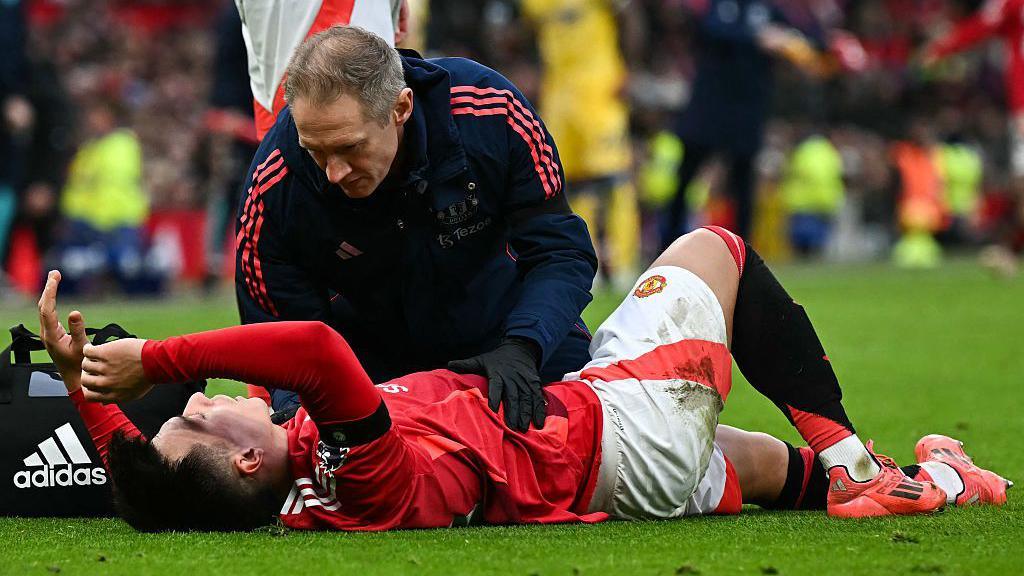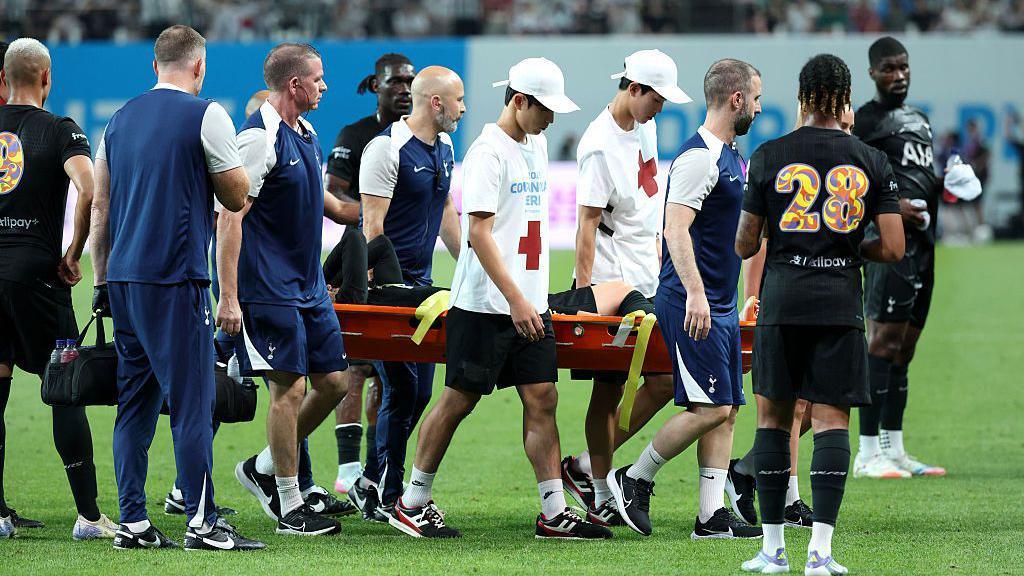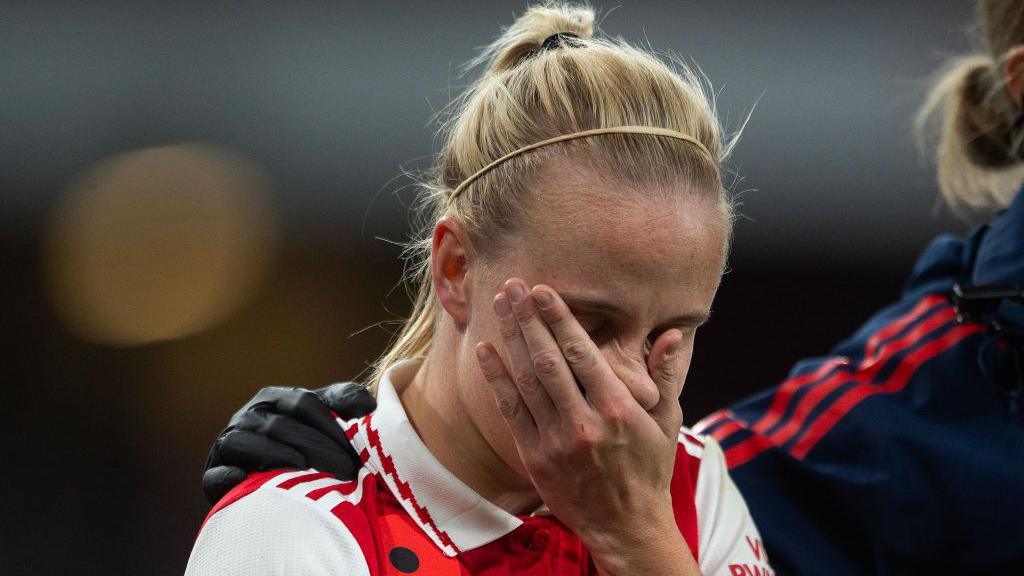What is an ACL injury and why is it so serious?
- Published
The anterior cruciate ligament (ACL) is an important band of connective tissue in the centre of the knee that helps to keep it stable.
When the ACL is injured it can cause pain, swelling and a feeling of the knee 'giving way', making it difficult to bear weight or participate in activities - particularly sport.
Scenarios that commonly lead to ACL injuries in football include rapid directional changes and landing after heading the ball.
If a footballer partially tears or ruptures their ACL, it often leads to them missing most - and in some cases, all - of a season, typically requiring six to nine months on the sidelines.
England forward Michelle Agyemang sustained an ACL injury on Tuesday during England's win over Australia.
Since August, Premier League footballers James Maddison, Levi Colwill and Giovanni Leoni have all sustained ACL injuries.
Sometimes, recovery can take even longer. Aston Villa duo Tyrone Mings and Emiliano Buendia both missed the duration of the 2023-24 season and the start of the following season due to ACL injuries.
In some cases, players can struggle to reach the capabilities they once played at due to the severity of an ACL injury - and there's the worry that the injury may return.
Get in touch
Send us your questions
Why does ACL recovery take so long?

Manchester United centre-back Lisandro Martinez was one of 10 players to suffer ACL injuries during the 2024-25 Premier League season
How quickly a player recovers from ACL injury can depend on their age, the severity of the injury and how the individual reacts to surgery.
Ben Warburton is a physiotherapist experienced in ACL rehabilitation, having worked with Cardiff City, Wales' national rugby union team and Scarlets.
Warburton says it will take a minimum of six months after surgery to get a player match-fit.
"Once you've had surgery, there's a lot of trauma to the knee," he explains. "Once that's calmed down, you've got to take it easy for the first three months. When you get past that three-month mark, you can rehab.
"Then it's a case of conditioning and training, getting the leg strong and getting the player back to running, training and games. That's why it takes so long."
Warburton says players who return to playing six months after ACL surgery are more likely to re-aggravate the injury than those who recover for nine months.
"You can go earlier [than six months], but it's a massive risk," Warburton adds.
"I don't know many surgeons who'd recommend to that. It has obviously happened. It hasn't not been successful, it's just unbelievably high-risk."
"A lot of it comes down to player profile as well," he adds. "If they're a really important player, you're going to push them early. If they're a developing player in the future, you're going to probably go more towards nine months."
What's next for Maddison and Colwill?

James Maddison was stretchered off during Tottenham's 1-1 draw with Newcastle in South Korea
Tottenham midfielder Maddison tore his ACL during Spurs' friendly with Newcastle in South Korea at the start of August and is expected to miss most of this season.
A day later, Chelsea defender Colwill suffered a similar blow during his first pre-season training session and underwent surgery shortly after
Both would have been vying for a spot in Thomas Tuchel's England squad, now that England's plans in the World Cup has been confirmed.
Severe ACL injuries are most commonly caused by a sudden increase in workload or due to fatigue.
Colwill's injury came just 21 days after winning the Club World Cup in a campaign where he made 47 appearances for club and country, while Maddison's occurred in his first game since missing the final six matches of last season with a knee injury.
A metric called the acute:chronic workload is used to assess an athlete's injury risk by comparing their recent training (acute load) to their longer-term training (chronic workload).
"They get a huge [training] spike in pre-season and that's where it's really hard to control it, because all the coaches want them to get fit quick - but the medical staff want them to stay fit," says Warburton.
"Maddison's just come back from a significant injury and then he gets back into training again - something goes when too much has happened too quickly."
Colwill, 22, is six years younger than Maddison and that age difference may mean the Chelsea man will have a shorter lay-off.
"If you're younger, you're going to heal quicker," adds Warburton.
Can an ACL injury end a football career?
As recently as 10 years ago, a serious ACL injury increased the likelihood that a footballer might have to retire.
But Warburton says nowadays, most footballers who have ACL surgery have between a 90-95% chance of returning to playing.
Advancements in technology and research are improving the management of ACL injuries, particularly in surgical decision-making and graft options.
Surgeons now have access to improved techniques for ACL reconstruction, including the transplant of a kneecap and hamstring tendons from donors.
"There's so much research now on the best grafts and the strongest graft for an ACL, and success rates," says Warburton.
"And there are so many tests that we put players through, through technology that wasn't available even 10 years ago."
Rates of a player reinjuring their ACL are heightened in the first 12 months following their return, meaning longer rest periods are key.
"What happens is players return and naturally their rehab goes down and their training and playing go up. So sometimes they lose quad [thigh muscle] strength and then with more game time fatigue kicks in," says Warburton.
"Within the first year, really the first six months, you've got to be careful. I think once you get past that period, you're a lot safer."
Why are ACL injuries so common in women's football?

Arsenal's Beth Mead suffered an ACL rupture during a Women's Super League match between Arsenal and Manchester United in November 2022
Studies show female footballers are two to six times more likely to suffer an ACL injury than their male counterparts.
In 2022, then-Arsenal trio Leah Williamson, Beth Mead and Vivianne Miedema all suffered ACL injuries in quick succession.
Research as to why this type of injury is more prevalent in women is ongoing, but anatomical differences are believed to play a role.
"[Women] have what's called a greater Q angle [the angle between the quadriceps muscle and the patellar tendon]," says Warburton, adding that this is because their pelvis is wider to facilitate childbirth.
A larger Q angle can cause the knee to move inward during movements such as jumping, which places more stress on the ACL.
Earlier this year, Fifa funded a research project into whether hormonal fluctuations during menstrual cycles could be contributing to the rise in ACL injuries in women's football.
Thank you to Phil in Warwickshire for the question.
This article is the latest from BBC Sport's Ask Me Anything team.
What is Ask Me Anything?
Ask Me Anything is a service dedicated to answering your questions.
We want to reward your time by telling you things you do not know and reminding you of things you do.
The team will find out everything you need to know and be able to call upon a network of contacts including our experts and pundits.
We will be answering your questions from the heart of the BBC Sport newsroom, and going behind the scenes at some of the world's biggest sporting events.
Our coverage will span the BBC Sport website, app, social media and YouTube accounts, plus BBC TV and radio.